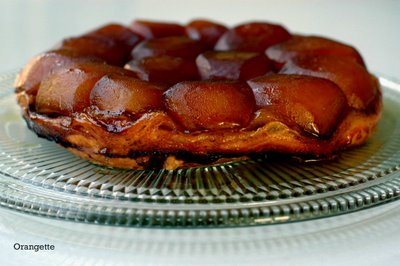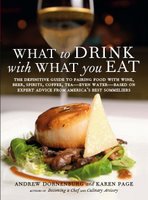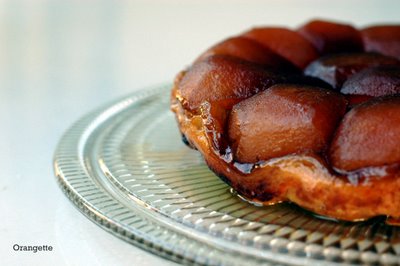A tokaji for your tarte Tatin
It doesn’t take much to make me bake something. A ripe banana crosses my path? I’ll bake a banana cake. A hunk of chocolate lands in my grocery cart? Clearly, I’m supposed to make some brownies. That pound of butter in the freezer? It’s very pushy, always begging to be used, foisting itself into batters and stuff. Gah. And with apple season upon us, you can well imagine the pressure I’ve been under. I must, I must, I must bake something! So when Andrew Dornenburg and Karen Page – authors of the must-have book Culinary Artistry, among others – dropped me a note to tell me about their newest title, What to Drink with What You Eat, I was elated. Not only did it give me a perfect excuse to bake a little something – all in the name of beverage pairing, you see – but it gave me good reason to drink a little something, or somethings, too.
As for what to bake, it was easy. Ever since I made my first tarte Tatin – in preparation for this piece over here – my stomach has rumbled at more or less regular intervals for its dark, winy flavor. Both complex and comforting, it is the flavor of fall, if you ask me – although I won’t exactly refuse it in winter, spring, or summer, either. [I’m a real pushover.] And given that it is late October, it seemed only fitting that I pick up a few local apples at the market, tuck them into a skillet, cover them with puff pastry, and turn them into a tarte Tatin.

And then – here comes the fun part – I would send said tart down the gullet with sips of, well, whatever Andrew and Karen told me to.
 The plan thus hatched, I sat by the door and waited for the book to arrive. A big, glossy tome with an inviting close-up on the cover, What to Drink with What You Eat is laid out in a fashion that reminds me – in a good way – of a foreign language dictionary. In this case, the “translations” are pairings: part of the book matches beverages to foods, and another matches foods to beverages. If you’re wondering what to drink with miso soup or cheese straws, you’ll want to search the first portion. On the other hand, if you’re curious about what foods go with the bottle of Chimay Blue in your fridge, you’ll want to flip to the second. Each type of food or beverage comes with a list of recommended pairings, some classic – pineapple with rum, or Stilton with port – and some surprising. [I would have never thought to put a glass of Fizzy Lizzy sparkling orange juice alongside a dessert with plums, but come to think of it, it just might work.] And for those seeking general principles and guidelines, there are also a few introductory chapters that explain everything from the sensuous science of balancing flavors to the temperature at which red wine is best served, with chatty, down-to-earth anecdotes. As for me, I headed straight for one page in particular: the one about apples, and apple desserts, more specifically.
The plan thus hatched, I sat by the door and waited for the book to arrive. A big, glossy tome with an inviting close-up on the cover, What to Drink with What You Eat is laid out in a fashion that reminds me – in a good way – of a foreign language dictionary. In this case, the “translations” are pairings: part of the book matches beverages to foods, and another matches foods to beverages. If you’re wondering what to drink with miso soup or cheese straws, you’ll want to search the first portion. On the other hand, if you’re curious about what foods go with the bottle of Chimay Blue in your fridge, you’ll want to flip to the second. Each type of food or beverage comes with a list of recommended pairings, some classic – pineapple with rum, or Stilton with port – and some surprising. [I would have never thought to put a glass of Fizzy Lizzy sparkling orange juice alongside a dessert with plums, but come to think of it, it just might work.] And for those seeking general principles and guidelines, there are also a few introductory chapters that explain everything from the sensuous science of balancing flavors to the temperature at which red wine is best served, with chatty, down-to-earth anecdotes. As for me, I headed straight for one page in particular: the one about apples, and apple desserts, more specifically.
Andrew and Karen suggest no fewer than 22 possible pairings for apple desserts, but for the sake of sanity – and so that I wouldn’t slump my way to work the next morning – I decided to choose just three: a sauternes, a Hungarian sweet wine called tokaji, and bourbon.* The first I had tasted before, but not with apples; the second I had read about but never tried; and the third was a shoo-in, seeing as a bottle of Woodford Reserve was sitting in our liquor cabinet. With the help of my preferred local wine shop, I chose a 2003 Château Lamothe Guignard Sauternes – a good year, the merchant told me – and a 2000 Royal Tokaji. A couple of hours and one warm tarte Tatin later, we were ready to taste.
Now, far be it for me to make bold exaggerations – I usually leave that to Brandon – but I discovered something momentous at the table that evening. It is this: apples were invented, I believe, for the express purpose of being served alongside a Hungarian tokaji. Sure, bourbon is lovely: smooth, spicy, with a whiff of vanilla and a delicious afterburn that together bring intrigue to the simplicity of apple. It’s awfully hard to quibble, too, with the soft sweetness of sauternes, or with its satisfying, syrupy mouthfeel. But the amber-colored tokaji was the only one that had us pausing to mull over its complex flavor – brown butter, butterscotch, silky, delicious – and then reaching for a refill. It not only made the tarte Tatin’s deep, caramelized flavor taste even deeper, but in turn, the tarte somehow made the tokaji taste even better too. Less sweet than sauternes and less cloying than bourbon, this stuff is addictively good; as Brandon said, “I want to drink the entire bottle.” But thank heavens he didn’t, because the little bit we have left – not to mention the other 19 pairings to be tried – gives me good reason to bake another tarte. Andrew and Karen, I owe you one.
* Brandon, Mr. Bourbon Man, was surprised to see that his beloved booze was not listed as a possible pairing under the word “apples.” But we flipped to the listing for whisky, and sure enough, there it was: “apples.” We assumed that whisky / bourbon’s absense from the apple listing was just a simple oversight, and so we forged ahead. Please pardon our boldness.
Tarte Tatin
Adapted from David Rosengarten’s Taste and Julia Child’s The Way to Cook
Don’t be intimidated by this classic dessert’s fussy look, or by the length of this recipe: it’s very straightforward. And I’m very verbose.

5-6 large apples, preferably Golden Delicious or Ginger Gold
Juice of 1 lemon
1 ½ cups granulated sugar
6 Tbs unsalted butter, divided
About 14 ounces puff pastry (store-bought, such as Dufour brand, is just fine; if frozen, be sure to let it thaw for about an before using)
Peel and quarter the apples, removing the cores such that each quarter has a flat inner side. Toss the apple quarters in a large bowl with the lemon juice and ½ cup of the sugar. Set aside for 30 minutes.
In a 9-inch cast-iron skillet set over medium heat, melt 4 tablespoons of the butter. Add the remaining 1 cup sugar, along with a few tablespoons of the apple-lemon juices. Stir to mix. Cook the mixture over medium-low heat, stirring regularly with a wooden spoon, for about 15 minutes, or until the mixture is a smooth, bubbly, pale caramel color.
Remove the pan from the heat and carefully add apple quarters, arranging them rounded-side-down in a decorative pattern. Arrange a second layer of apples on top wherever they fit, closely packed. This second layer need not be terribly neat. Top the apples with the remaining 2 tablespoons of butter, cut into dice.
Preheat the oven to 375 degrees Fahrenheit.
Cook the apples over medium-low heat for about 20 minutes, occasionally spooning the bubbling caramel liquid over them. Press them down gently with the back of a spoon — don’t worry if they shift a bit in the liquid; just move them back to where they were — and watch to make sure that no one area of the pan is bubbling more than another. Shift the pan as necessary so that the apples cook evenly. They are ready when the liquid in the pan has turned to a thick, amber ooze. The apples should still be slightly firm. Do not allow them to get entirely soft or the liquid to turn dark brown. Remove the pan from the heat.
On a floured surface, roll the puff pastry out to a thickness of about 3/16 inch. Using a sharp, thin knife, trace a circle in the pastry about 10 inches in diameter (1/2 inch wider all around than the skillet), and trim away any excess. Carefully lay the pastry circle over the apples in the skillet, tucking the overlap down between the apples and the inside of the pan.
Place the skillet on a rimmed baking sheet, and bake for about 30-35 minutes, until the pastry has risen, and is dry and golden brown. Remove the skillet from the oven, and let it to rest for a minute or two. Tilt the pan and look down inside the edge: if there is a lot of juice, pour most of it off into the sink. [Do not pour it all off, or the apples may stick to the pan.] Place a serving platter upside-down over the skillet and, working quickly and carefully (it’s hot!), invert the tart onto the platter. Rearrange any apple slices that may have slipped or stuck to the skillet. Serve warm or at room temperature, preferably with a tokaji.
Yield: 8 servings – or less, if you, like me, like seconds

